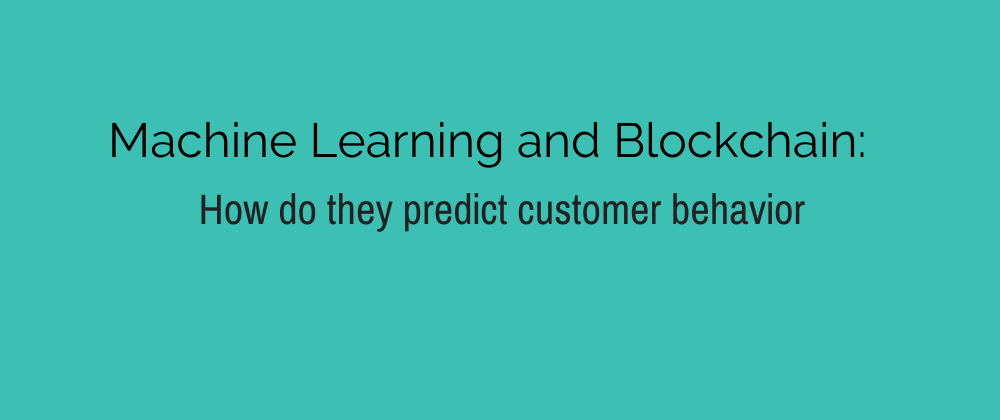Artificial Intelligence and Machine Learning are the top buzzwords in the tech industry, and these terms are often confused with one another. The word Artificial intelligence refers to the simulation of human intellect in computers that are programmed to think and act like humans and also mimic their behaviors. In contrast, Machine Learning is a part of Artificial Intelligence. It is the science of creating and implementing algorithms that are capable of learning things from past occurrences.
In the present world, having a business-oriented strategy won’t be enough unless the preference and the choice of the customer are known. In order to sell their products efficiently, the businesses must know the behavior of their customers which in turn enhances the chance of a conversion. For any business, being able to contemplate the behavior of the customers has three main advantages. It can drive customer satisfaction, limit exhaustion of customers, and increase the ROI(Return on Investment) of the company. The most familiar strategy, followed by several ‘AI-based’ start-ups, is to recognize the next customer by mining the data on the internet. They study the information about what people are discussing in social networks and then identify the ones who search for a particular service or product.
One of the greatest benefits of Machine Learning is with regards to targeting possible customers and generate quality leads. The ability to grasp the data of the customer and apply machine learning algorithms to predict their behavior, thereby enhancing the consumer experience, is a significant feature. Its other advantages include:
Filtered delivery of content
Smarter advertisements
Chatbots
Response time optimization
Virtual assistants
But how does one predict customer behavior?
This is where Machine Learning comes into play. Machine Learning algorithms are used to predict the behavior of the customer based on historical data and are accurate about 60% of the time. The machines learn from history to generate strong results.
While we humans don’t follow a well-determined logic, we do possess a few repeated patterns. We usually buy the same items, act similarly, and follow similar instincts. If we observe Machine Learning algorithms, the most widely used one is Neural Networks. The main reason for using this algorithm is that it can generate an estimate of any purpose. This is based on the data on which it is trained or which it learns. The ML algorithms use statistics and computer science to predict logical outputs. The prediction of future events is based on the data of past events. If there is no data, there is no prediction.
Another approach is the Predictive analytics. Predictive analytics is a domain based on Artificial Intelligence and Big Data, which is driven by predictive modeling. Predictive analytics and machine learning work together as predictive models include a machine learning algorithm. In order to train the predictive models, an enormous amount of data is to be fed to the models. With so much data being fed, there are many patterns of consumer behavior that emerge.
Unfortunately, utilizing data in a way to derive trends and actionable information comes with a lot of restrictions. The 40% inaccuracy in predicting customer behavior cannot be denied. Qualified specialists are limited, costly, and it takes years to master and create new ones. And till now, this has been a fundamental drawback of using predictive analytics.
Therefore, it looks like blockchain technology can offer feasible and practical resolutions for the challenges that occur due to these approaches and even more. Let’s first understand what blockchain technology is all about.
What is Blockchain?
Blockchain technology is usually related to Bitcoin and other cryptocurrencies. But, this isn’t the situation anymore. This technology relies on the concept of a distributed ledger. Therefore, blockchain is largely a record of all transactions from the start which is maintained and updated by a pool of singular machines continuously. There are some characteristics that might make this technology a viable solution for some issues in the future including predictions, security, and many more. Blockchain technology in cybersecurity holds a lot of promise for safety but there is a long way to go before organizations start adopting this technology.
Blockchain technology is decentralized, meaning it enables data to be distributed without a central unit. Hence, transactions can be verified and processed independently. It is consistent and durable i.e., the technology has the ability to resist any harmful attacks on the system. Also, the data, authenticity, and the timelines provided by blockchain technology are precise.
As a distributed ledger, Blockchain can handle any action in occurrence. This is the prime reason behind its quickly increasing power and popularity. It is designed specially to simplify and stimulate the process of the transactions being recorded. This means that any products can be transacted transparently with the help of the decentralized network.
Also, Blockchain is the most secure database that saves time-stamped, unalterable, permanent occurrences of data. It utilizes digital signatures and a uniform mechanism in order to assign digital ownership to the blockchain entities. The outcome is a profoundly decentralized ledger which is very repellent to restriction from governments or other malicious participants. This makes Blockchain a suitable prospect to save sensitive data that cannot be altered in any form.
The Merging of Machine Learning and Blockchain
Machine learning depends on the enormous amounts of data to develop models for specific predictions. Most of the expenses incurred in acquiring this data lie in gathering, arranging, and reviewing the data for correctness. This is an aspect that can be improved significantly with the help of blockchain technology.
Recently, a Machine Learning start-up company called, GNY claimed to have discovered a solid solution to improve the precision and effectiveness of the present-day recommendation and prediction systems using ML and Blockchain technology. The solution focuses on giving the businesses of all sizes, the knowledge to identify different patterns in the data of their customers and predict the most suitable time to promote their products and boost their sales. This is done with the help of hundreds of Machine Learning algorithms that work with one another and respond to millions of independent variable characteristics.
According to GNY, smart APIs have been paired with a universal operating language, and this enables developers to “easily access the power of machine learning.” The company says its ecosystem has successfully tested cross-chain transactions for Bitcoin, Asch, and Ethereum, and in the future, it will add further side-chain capabilities with Lisk and other chains in order to facilitate further expansion.
Benefits of Machine Learning and Blockchain
When the two technologies are put together, they complement one another and improve. It is up to businesspeople to explore new methods to utilize them in order to attain the advantages of profound insights, higher productivity, and responsibility. This trend is rising and is drawing an exceptional amount of recognition from businesses across the globe. Here’s how their combination can benefit organizations.
The increased power of computing: The new developments in areas like Artificial Intelligence and Machine Learning will drive the future of our society. But since this development requires enormous quantities of computational power and hardware, Blockchain is used. It provides the computational sources Artificial Intelligence requires by using the computing power of computers that contain unused GPU computing power.
Decreased computing costs: Quarterly, the demand for Artificial Intelligence computations is multiplying with the proportional rise in costs. Established suppliers of computation power, such as Microsoft and Amazon, are using cost as leverage to regulate usage, which limits innovation. Blockchain-based resolutions are now striving to build decentralized marketplaces. This will lead to a decrease in computational costs.
Improved data integrity: Blockchains build an atmosphere where data is private, permanent, open, shared, and is easy to work on without the control of a government. Blockchain will also serve as the data feeds into Artificial Intelligence patterns, which will be vital to maintaining the validity of the standards. It also holds the commitment of joining accountability and structure to Machine Learning algorithms, as well as the nature and value of the intelligence they generate.
Conclusion:
Machine Learning and Blockchain could be an influential jump in predicting customer behavior patterns. Furthermore, using these technologies in a business can solve many issues like a fraud in various industries. This means that the merging of Machine Learning and Blockchain Technology paves the path for a much more clear and productive world. The innovation of blockchain technology and the susceptibility to operating in harmony with ML will also enhance machine to machine corporations.
Both technologies serve to improve the abilities of each other while additionally giving chances for much better attention and responsibility, and this combination will transform many industries. These include retail, manufacturing, healthcare, government, and many more.
The industry-wide initiative of this technology can present new business applications and opportunities over various domains. Organizations implementing this technology will give them an edge over their competitors in the respective industries, no matter what strategy they deploy. Businesses must start, including Blockchain and Machine Learning, within their organizational strategies so that they do not stay behind in the competition.
Author Bio: I am Amelia Emma, I love diving deep into Education & health topics. I particularly write about Education trends, & health tips. I am a regular contributor to Greycampus, Momjunction, Medicalbreakthrough, etc.







Top comments (0)